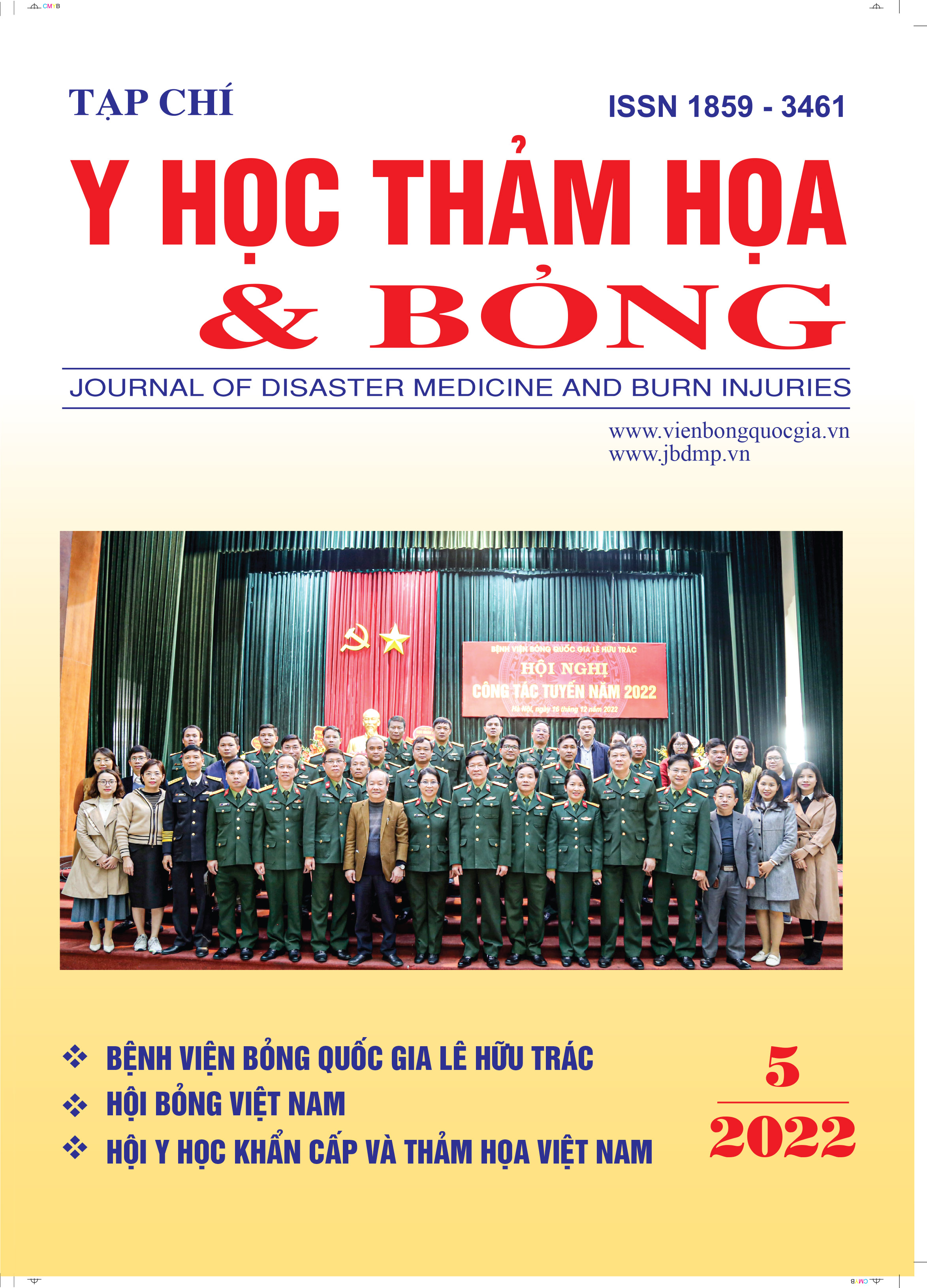The paraclinical, bacterial and histopathological effectiveness of Berberine nano gel on wound healing in rabbits
Main Article Content
Abstract
Berberine is isolated from the plant Coscinium fenestratum and some plants in the family Ranunculaceae has affected wound healing and burn healing. The research to determine the repair of full skin loss wounds of rabbits on the subclinical and histopathological development with Berberine nano gel produced by the National Burn Hospital. Conducted on 45 rabbits, creating a skin loss of 3.5cm of diameter on each side of the rabbit's back (2 wounds/rabbit), rabbits were separated into 3 groups (15 rabbits, 30 wounds/each group), research group (Group A): Topical treatment with Berberine nano gel, control group (Group B): Topical treatment with SSD 1%, standard group (Group C): topical treatment with 0.9% Sodium Chloride.
Monitor the progress of hematological and biochemical tests, microbiology at the VT surface during the study, and the histopathology of rabbit liver, spleen, and kidney at the end of the study.
Results: There was no difference in laboratory tests or histopathology between the 3 groups of rabbits; Group A wound has a significantly lower infection rate than the wound in group B and C.
Conclusion: Berberine nano gel for treating skin loss wounds has been demonstrated in the study to be safe, bacteria-inhibiting.
Article Details
Keywords
Berberine nano gel, rabbit, skin loss wound
References
2. Stephens P, Caley M, Peake M. Alternatives for animal wound model systems. In: RG Gourdie, TA Myers, eds. Wound Regeneration and Repair Methods and Protocols. New York, NY: Humana Press; 2013: 177-201.
3. Stojadinovic O, Tomic-Canic M. Human ex vivo wound healing model. In: RG Gourdie, TA Myers, eds. Wound Regeneration and Repair Methods and Protocols. New York, NY: Humana Press; 2013: 255-264.
4. Daniela S. Masson-Meyers, Thiago AM Andrade, Guilherme F Caetano, Francielle R Guimaraes, Marcel N Leite, Saulo N Leite, Marco Andrey C Frade, Experimental models and methods for cutaneous wound healing assessment. Int J Exp Pathol, 2020. 101(1-2): p. 21-37.
5. Anna Och; Rafał Podgórski, R.N., Biological Activity of Berberine-A Summary Update; 2020, 12(11), 713. Toxins, 2020. 12(11): p. 713.
6. Nasef M, K.H.A., Ashour M A, Nassar S L, Selim N M, El-Raey M A; Biological Investigations of a New Natural Recipe Expected to Promote Healing of Superficial Burns; International Journal of Pharmaceutical and Clinical Research 2016. 8(8): p. 1230-1239.
7. Lê Thế Trung (2003), “Bỏng những kiến thức chuyên ngành”, NXB Y học
8. Wang Y., Z.J.A., Update on the Benefits and Mechanisms of Action of the Bioactive Vegetal Alkaloid Berberine on Lipid Metabolism and Homeostasis. Cholesterol., 2018. 2018: p. 717.
9. E. Mirhadi, M. Rezaee, and B. Malaekeh-Nikouei (2018), “Nano strategies for berberine delivery, a natural alkaloid of Berberis”, Biomed. Pharmacother., 104, pp.465-473.
10. Nguyễn Ngọc Tuấn, Lê Quốc Chiểu, Ngô Ngọc Hà; Nghiên cứu tác dụng điều trị vết thương thực nghiệm của gel nano Berberin trên lâm sàng, Tạp chí Y học thảm họa và Bỏng, số 3, 2022,trang 22-36.
11. OECD guideline for the testing of chemicals, 402, 2017
12. Nguyễn Thị Tỵ (1989); Tác dụng điều trị tại chỗ vết thương bỏng thực nghiệm của tinh dầu tràm và bước đầu ứng dụng lâm sàng, Luận án PTS khoa học Y Dược, Học viện Quân y, Hà Nội.
13. Bộ Y tế, Hướng dẫn Quy trình kỹ thuật chuyên ngành vi sinh, NXB Y học, 2018.
14. Nguyễn Ngọc Tuấn, Lê Quốc Chiểu, Lê Thị Hồng Hạnh; Acute toxicity of nano Berberine gel in white mice.Tạp chí y học thảm họa và bỏng, số 6, 2021,trang 10-20
15. Nguyễn Ngọc Tuấn, Lê Quốc Chiểu, Nguyễn Thái Biềng; Nghiên cứu tính kích ứng da của gel nano Berberin trên da lành của động vật thực nghiệm; Tạp chí Y học thảm họa và Bỏng, số 2, 2022, trang 14-23.
16. Nguyễn Ngọc Tuấn, Lê Quốc Chiểu, Bùi Thị Bích Vân, Đặng Văn Điệp; Nghiên cứu độc tính bán cấp trên lâm sàng của gel nano Berberin ở chuột cống trắng; Tạp chí Y học thảm họa và Bỏng, số 2, 2022,trang 37-45.
17. Nguyễn Ngọc Tuấn, Lê Quốc Chiểu, Nguyễn Thuỳ Linh; Nghiên cứu độc tính bán cấp của gel nano Berberin trên cận lâm sàng và giải phẫu bệnh ở chuột cống trắng; Tạp chí Y học thảm họa và Bỏng, số 3, 2022,trang 61-73.
18. Timothy C, B.N.D., Gregory ND, Berberine: Therapeutic potential of an Alkaloid found in several medicinal plant, Alt Med Rev, 1997. 2(2): p. 94-103.
19. Amin AH, S.T.V., Abbasi KM; Berberine sulfate: antimicrobial activity, bioassay, and mode of action, Can J Microbiol, 1969. 15: p. 1067-1076.
20. Stermitz FR, L.P., Tawara JN, et al., Synergy in a medicinal plant: Antimicrobial action of berberine potentiated by 5′-methoxyhydnocarpin, a multidrug pump inhibitor, Proc Natl Acad Sci USA, 2000. 97(4): p. 1433-1437.
21. Yu HH, K.K.J., Cha JD et al., Antimicrobial Activity of Berberine Alone and in Combination with Ampicillin or Oxacillin Against Methicillin-Resistant S. aureus, Journal of Medicinal Food., 2005. 8(4): p. 454-461.
22. Košťálová; M.Č.D., Antimicrobial activity of berberine - a constituent of Mahonia aquifolium; Folia Microbiologica; 2002. 47(4): p. 375-378.
23. Muhammad Umar Khayam Sahibzada, A.S., Hani S Faidah et all; Berberine nanoparticles with enhanced in vitro bioavailability: characterization and antimicrobial activity. Drug Des Devel Ther., 2018. 12: p. 303-312.
24. Zhenqiang Liu, Yanchao Liu, Ting Fang, Jianhua Xia, Ning Ma, and Yanhong Wang, Application of berberine-loaded albumin nanoparticles in infections of traumatic wounds, Int J Burns Trauma. 2022; 12(1): 28-34, Published online 2022 Feb 15.
25. Mohammed Al-Awady; Adelaide Fauchet, Gillian M Greenway; Vesselin N. Paunov; Enhanced antimicrobial effect of berberine in nano gel carriers with cationic surface functionality; Journal of Materials Chemistry, September 2017; B 5(38).
26. Suliman Khan, Arif Hussain, Farnoosh Attar, Samir HajBloukh, ZehraEdis, MajidSharifi, review of the berberine natural polysaccharide nanostructures as potential anticancer and antibacterial agents; Biomedicine & Pharmacotherapy; Volume 146, February 2022, 112531.


